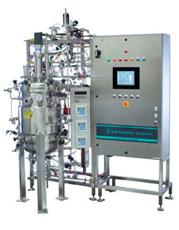ADVANTAGES OF MINIFOR BIOREACTOR FOR CELL CULTURES

New improvements in cell culture:Easy sterility:
Elimination of critical points makes the keeping of sterility easy. A strong silicone membrane isolates completely the vessel from the environment. The sterility is equivalent to magnetic coupling but is considerably less complex and much less expensive. All o-rings have been replaced by large silicone stoppers with multipoint seals. They are permanent and need not be frequently replaced, as it is the case with o-rings (which become flat after sterilisation).
Very gentle mixing with new Fishtail stirrer:
Up and down movement of one or more stirring discs provides gentle mixing both in horizontal and vertical direction. At the same time the stirring is more efficient. A special proprietary disc form of the new elastic Fishtail stirrer (mimics the fish tail) eliminates cutting edges and micro-eddies formed on all common impellers. Therefor the cell viability is increased.
Adapter for very sensitive cells:
A spiral covered by a thin wall of air containing silicone tubing is fixed on the axis of the stirrer. The up and down movement of the spiral displaces oxygen saturated layers of the culture and simultaneously produces a gentle movement of the medium. Because oxygen saturated layers in the proximity of the gas supplying tubing are removed fast, the moving spiral system is more efficient than common stationary systems.
Radiation heating:
The infrared radiation concentrated on the bottom of the vessel produces extremely gentle and regular sun like heating of the culture! It produces natural convection even without agitation. No hot spots are formed at any culture volume. Thanks to the very low heat capacity of the radiator, the temperature can be attained in a short time and can easily be kept constant. Furthermlore the sight into the vessel is not hindered.
Culture volumes from 35 ml to 6000 ml:
A broad volume spectrum is possible with just one instrument. Since no expensive top plates are used, the cost of passing from one volume vessel to another is several times lower than in other systems.
MINIFOR is very compact:
The MINIFOR is the most compact bioreactor available. Nevertheless, the ports are well accessible from all sides.Fastest set up: Special system and vessel construction of MINIFOR allows the fastest set up when compared to all other systems on the market.
Fully automatic gas flow:
Lambda discarded all rotameters and manual valves on so called four gas stations. Their reading is pressure and temperature dependent and cannot be well reproduced. Additionally, they cannot be automatically regulated and do not supply any recordable signal. A new gas flow meter and controller MASSFLOW has been developed. The gas flow measurement is based upon the precise massflow principle and is unaffected by pressure and temperature variations. It supplies a high quality signal, which is used to control our proprietary proportional valve for a precise regulation of the gas flow rate. The gas volume can be measured, totalised and recorded for the control of metabolic activity of the culture.
Automatic pH and pO2 control:
The carbon dioxide regulating MASSFLOW instrument is just plugged into the acid pump socket on the rear of the MINIFOR and if necessary the nitrogen regulating MASSFLOW to the base pump socket. The MINIFOR will keep both pH and pO2 on the preset value automatically.
Self-cleaning gas microsparger:
Rich and salt containing media will inevitably dry out in the openings of a sparger tube. Solid deposits may block the gas entry. A special microsparger has been developed by Lambda to eliminate this problem.
Continuous culture:
The weight of MINIFOR can be kept constant by using a special weighing module placed under the front edge of MINIFOR. The harvesting pump will keep automatically the volume of the culture constant. Continuous cultures allow a considerable increase of productivity.
INTEGRATOR:
When the integrator is switched to pumps or MASSFLOW gas flow regulator, their activity can be followed as a function of time. The data obtained in this way give additional information about the culture; it's growth kinetics and reproducibility.
PC control:
Easy to use, complete software FNet for up to six MINIFOR units.
All these features result in a dramatic improvement of the cell culture, precise control of preset parameters and their easy documentation.
Advantages of using non-isothermal bioreactors for the enzymatic synthesis of antibiotics: The penicillin G acylase as enzyme model
A new hydrophobic and catalytic membrane was prepared by immobilizing Penicillin G acylase (PGA, EC.3.5.1.11) from E. coli on a nylon membrane, chemically grafted with butylmethacrylate (BMA). Hexamethylenediamine (HMDA) and glutaraldehyde (Glu) were used as a spacer and coupling agent, respectively. PGA was used for the enzymatic synthesis of cephalexin, using D(-)-phenylglycine methyl ester (PGME) and 7-amino-3-deacetoxycephalosporanic acid (7-ADCA) as substrates. Several factors affecting this reaction, such as pH, temperature, and concentrations of substrates were investigated. The results indicated good enzyme-binding efficiency of the pre-treated membrane, and an increased stability of the immobilized PGA towards pH and temperature. Calculation of the activation energies showed that cephalexin production by the immobilized biocatalyst was limited by diffusion, resulting in a decrease of enzyme activity and substrate affinity. Temperature gradients were employed as a way to reduce the effects of diffusion limitation. Cephalexin was found to linearly increase with the applied temperature gradient. A temperature difference of about 3°C across the catalytic membrane resulted into a cephalexin synthesis increase of 100% with a 50% reduction of the production times. The advantage of using non-isothermal bioreactors in biotechnological processes, including pharmaceutical applications, is also discussed
